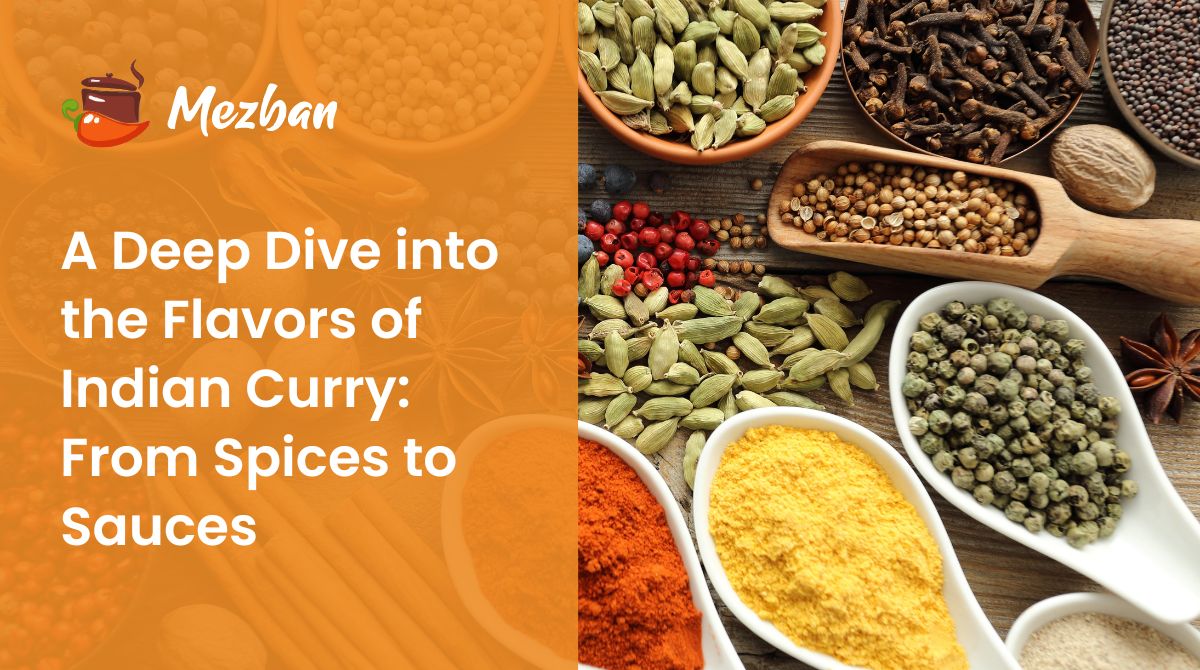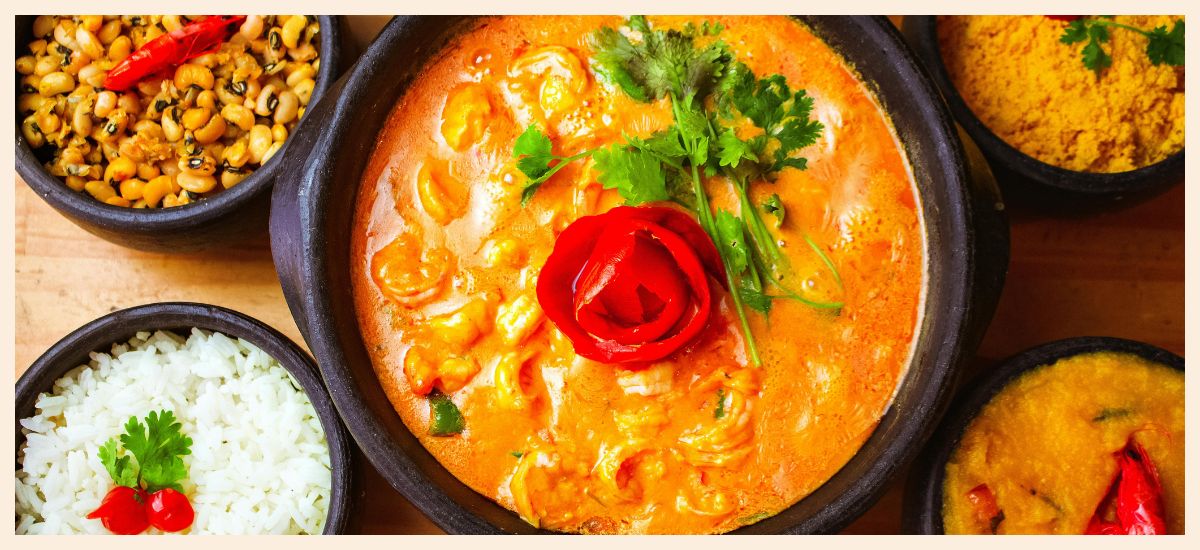Indian curry is more than just a dish—it’s a vibrant, aromatic journey through the rich culinary heritage of the subcontinent. Whether you’re savoring the warmth of a rich chicken tikka masala or enjoying the delicate spices of a vegetarian dal, Indian curries offer a unique and unforgettable dining experience. But what makes Indian curry so special? The magic lies in its spices, the art of cooking, and the sauces that bind them together. Let’s take a deep dive into the flavors of Indian curry, exploring the key spices, cooking techniques, and sauce varieties that create this beloved dish.

The Foundation of Indian Curry: Spices
At the heart of any Indian curry is a complex blend of spices. Unlike Western cuisine, which often uses a limited number of spices for seasoning, Indian curry is an explosion of flavors, with every spice playing a specific role in creating depth and balance. Here are some of the essential spices that form the foundation of Indian curry:
1. Cumin (Jeera)
Cumin is one of the most versatile spices in Indian cuisine. It has a warm, earthy flavor that forms the backbone of many curry recipes. Cumin can be used both as whole seeds, which are often roasted or fried in oil, or ground into powder to enhance the flavor of the curry sauce.
2. Coriander (Dhania)
Coriander adds a mild citrusy flavor to curry dishes. It’s used both as ground powder and as fresh leaves (cilantro), which garnish the dish before serving. Ground coriander is often mixed with cumin to create a flavorful base for many Indian curries.
3. Turmeric (Haldi)
Known for its golden color and earthy, slightly bitter flavor, turmeric is essential in many curry dishes. It’s often used as a coloring agent and provides a subtle, warm undertone to the curry sauce. Beyond flavor, turmeric is celebrated for its anti-inflammatory properties.
4. Garam Masala
Garam masala is a spice blend that varies by region, but it typically contains ingredients like cinnamon, cloves, cardamom, black pepper, and bay leaves. This warm, aromatic mix is often added towards the end of cooking to provide a burst of fragrance and complexity.
5. Chili Powder (Lal Mirch)
For those who like their curries with a bit of heat, chili powder is the go-to spice. It ranges from mild to hot, depending on the variety used. Chili powder not only provides spice but also contributes to the color of the curry.
6. Fenugreek (Methi)
Fenugreek has a slightly bitter flavor and is often used in small amounts to balance the richness of curry dishes. Its leaves are used in some curries, while its seeds provide a subtle earthy note.
7. Mustard Seeds (Sarson)
Mustard seeds add a pungent kick when fried in hot oil and are a common feature in South Indian curries. They provide an aromatic heat that complements the other spices in the dish.
These spices are typically combined in various ways to create the “masala” base, which is the foundation of Indian curries. The key to mastering Indian curry lies in understanding how these spices interact and how they are layered during cooking to create a harmonious, full-bodied flavor.
The Art of Tempering: Tadka
One of the secrets to a flavorful Indian curry lies in the technique of tempering (also known as tadka or baghar). This process involves heating oil or ghee (clarified butter) in a pan and adding whole spices like mustard seeds, cumin, or curry leaves. The spices “pop” in the hot oil, releasing their essential oils and aromas, which infuse the curry base with deep, rich flavor.
Tempering is often done at the beginning of cooking to form the flavor base or at the end, right before serving, to enhance the fragrance. This technique is widely used in Indian cooking, especially in curries, to achieve that aromatic complexity that makes Indian food so distinctive.
Sauces: The Heart of the Curry
The sauce is the soul of an Indian curry. Whether it’s a creamy tomato base, a rich coconut milk sauce, or a tangy yogurt-based gravy, the sauce ties together the spices and brings the dish to life. Here are some of the most common sauces used in Indian curry:
1. Tomato-Based Curries
One of the most common curry bases is a tomato-based sauce. The acidity and sweetness of tomatoes create a rich, tangy backdrop for a variety of spices. Butter chicken (Murgh Makhani) and chicken tikka masala are popular examples of tomato-based curries. The tomatoes are often cooked down into a smooth puree, blended with spices like cumin, coriander, and garam masala, to create a luscious, hearty sauce.
2. Coconut Milk-Based Curries
In southern India and coastal regions, coconut milk plays a major role in curries. It adds a creamy, mild sweetness to the dish and balances out the heat from chili and the bitterness of certain spices. Kerala’s famous fish curry and the South Indian Chettinad chicken curry are great examples of coconut milk-based curries, with a rich and velvety sauce that enhances the flavors of the spices.
3. Yogurt-Based Curries
Yogurt is a common base for curries, especially in North India. It provides a cooling effect, which works well to balance out the heat of the curry, while also contributing to a creamy texture. Dishes like chicken korma and lamb rogan josh are made with yogurt-based sauces, which provide a rich, smooth consistency and a slight tanginess.
4. Cream-Based Curries
For a richer, more indulgent curry, cream is often added to the sauce. Butter chicken is a prime example of this creamy, luxurious curry style. The combination of tomatoes, cream, and a handful of spices creates a smooth, velvety sauce that coats the meat and vegetables perfectly.
5. Lentil-Based Curries
Lentils (dal) are another crucial component of Indian curry. While not typically thought of as “sauces,” lentil-based curries like dal tadka are rich, flavorful, and deeply satisfying. The lentils absorb the spices, creating a thick, hearty gravy that is often served with rice or bread.
Regional Variations: A World of Curry
India is a vast country, and each region has its own distinct approach to curry, resulting in an array of unique flavor profiles. In the North, the curries are often tomato- or cream-based, with milder heat and a focus on rich, slow-cooked gravies. In contrast, the South uses more coconut milk, curry leaves, and tamarind for tangy, refreshing flavors. In Western India, particularly in Gujarat and Rajasthan, you’ll find curries that balance sweet and savory elements, often incorporating jaggery (unrefined sugar) and yogurt.

Conclusion: The Soul of Indian Curry
Indian curry is a true celebration of flavor, blending the earthiness of spices with the richness of sauces to create a dish that is both comforting and exciting. From the essential spices to the variety of sauces, every element plays a crucial role in building the depth and complexity of the dish. Whether you prefer a mild, creamy curry or a fiery, spicy one, the beauty of Indian curry lies in its versatility. Each bite is a journey through history, culture, and an explosion of flavors, making it one of the most beloved and sought-after dishes in the world.
So next time you sit down to enjoy an Indian curry, take a moment to appreciate the intricate layering of spices and sauces that come together to create a masterpiece on your plate. flavors of Indian curry are waiting to be discovered, one curry at a time.

